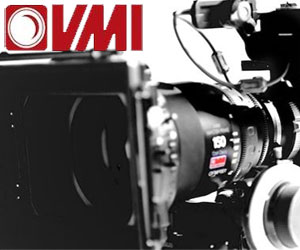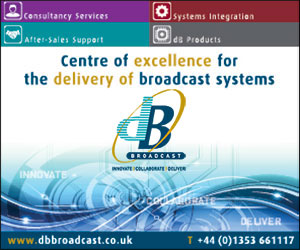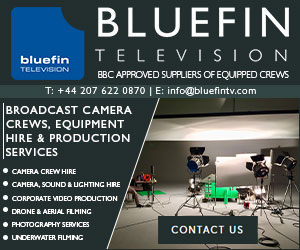Broadcast News
12/12/2017
Evolving IP Standards

The earliest deployments of IP video transport began around 2001, when one large cable company sought ways of reducing the quantities of coax associated with the use of ASI for transporting video.
Although initially not standardised, the distribution of MPEG-2 Transport Streams (TS) began the transition to IP video. dB Broadcast became the UK's leading integrator and installer of encoding and compression systems, and by around 2007 they were installing and commissioning fewer ASI coax systems than IP based systems. This major shift meant the company had to develop internal expertise in video over IP, networking technology and, in particular, configuring IP switches.
In the period 2007–2011, SMPTE defined four standards for the transport of MPEG-2 TS over IP (SMPTE ST 2022-1:2007 to ST 2022-4:2011). In 2012 and 2013, SMPTE extended these with the addition of three new ST 2022 standards for the transport of 'high bitrate media signals' (uncompressed video) over IP networks (SMPTE ST 2022-5:2013, ST 2022-6:2012 and ST 2022-7:2011). ST 2022-5 is a standard method for providing forward error correction (FEC), ST 2022-6 is a standard method for the carriage of SDI over IP and ST 2022-7 is a standard method for seamless protection switching of ST 2022-6 streams.
Yet while these new standards would bring enhanced flexibility and demonstrable cost savings over the long term, the pace of change was presenting new challenges as the products, standards and skills necessary to realise this vision fully were not in place. This required workarounds and bespoke approaches – a challenge that dB Broadcast was uniquely placed to address.
For example, a global technology company chose dB as its partner to help design and implement its flagship London production facility for its content creators. Yet in 2016 when this project was undertaken, the move to IP was still at an early stage. One of the biggest challenges at this time was that IP video systems were transitioning from proof-of-concept (PoC) test systems to operational production facilities while many products were not yet interoperable using the SMPTE standards, or had not been tested 'at scale'. Consequently this project was successfully delivered using a proprietary solution for video, audio and metadata over IP and the use of IP infrastructure made this 4K equipped facility extremely versatile.
Also during 2015–16, dB Broadcast was working with industry suppliers to create PoC systems based on the emerging SMPTE ST 2022 suite of standards, and in 2017, dB delivered the first fully IP production centre in the UK based on SMPTE ST 2022-6 and -7, at a major new facility sited in the City of London.
It should be noted that all the of the ST 2022 media transport standards are related to the carriage of multiplexed data, that is video, audio and any metadata are all carried together on a single IP stream as shown below:
As the SDI payload is intended to carry video, audio and metadata, it is quite inflexible. If, for example, an audio mixing desk needed to access a stereo pair, it would have to receive the entire stream and de-embed the required pair. Although it is possible to send audio via separate flows using AES67, this is wasteful of bandwidth as the ST 2022-6 stream uses a constant bandwidth irrespective of whether embedded audio is carried or not.
To address these concerns, in 2015 the Video Services Forum (VSF) proposed TR-03, which separates the video, audio and metadata essence into discrete flows. By using separate flows, TR-03 avoided wasted bandwidth and offered greater flexibility to the production team by accessing only the flows they needed. In the case of the audio desk above, it would need to receive only the flow carrying the required stereo pair.
What the broadcast market needed was a single SMPTE standard that used the same basic principles as TR-03, and with the industry aligning around the Alliance for IP Media Solutions (AIMS) roadmap during 2016/17, that requirement resulted in the development of the new ST 2110 suite of standards.
ST 2110 is founded on TR-03 but goes much further in its ambitions. The core of the new suite is ST 2110-10 'System Timing and session description', with several other parts dealing with 'Uncompressed Active Video' (based on RFC 4175), 'PCM Audio' (based on AES67) and 'Ancillary Data' (based on ST291). The separate video and audio essence flow parts are derived from those specified by TR-03. The basic structure of these flows is shown below:
SMPTE ST 2110 offers all the flexibility and bandwidth advantages of essence-based media IP flows, with the reassurance that comes from a unified industry standard that ensures the same interoperability we have enjoyed with SDI for almost thirty years.
One of dB Broadcast's biggest challenges in seeking to implement emerging standards, such as SMTPE ST 2110 is that it may lead to interoperability challenges between different products, an issue that needs to be carefully managed by the system integrator.
To provide easier interoperability and configurability within IP networks, there has been a trend towards the use of Software Defined Networks (SDNs), which allow networks to be programmatically configured and managed. In the broadcast world, the AMWA Networked Media Open Specifications (NMOS) is a suite of open specifications that, amongst other capabilities, allows device discovery and registration (IS-04), connection management (IS-05) and network control (IS-06). Although NMOS is a work in progress, it will in time provide an open framework for the interoperable configuration and management of broadcast IP networks.
In the UK, the BBC is committing to these emerging standards and for its new BBC Wales headquarters currently being built in Central Square, Cardiff, the BBC have specified a facility based on the new SMPTE ST 2110 standards and AMWA NMOS IS04.
During 2018 and 2019 dB Broadcast will be working closely with customers and key IP video technology suppliers to deliver systems based on ST 2110. dB has extensive experience and capability in broadcast engineering, and already has a proven track record in implementing IP based systems based on emerging standards, and integrating best-of-breed software products from multiple suppliers.
Image: Simplified SMPTE ST 2110 IP Packet Format.
www.dbbroadcast.co.uk
This article also features in the December edition of Broadcast Film & Video.
(JP/LM)
Although initially not standardised, the distribution of MPEG-2 Transport Streams (TS) began the transition to IP video. dB Broadcast became the UK's leading integrator and installer of encoding and compression systems, and by around 2007 they were installing and commissioning fewer ASI coax systems than IP based systems. This major shift meant the company had to develop internal expertise in video over IP, networking technology and, in particular, configuring IP switches.
In the period 2007–2011, SMPTE defined four standards for the transport of MPEG-2 TS over IP (SMPTE ST 2022-1:2007 to ST 2022-4:2011). In 2012 and 2013, SMPTE extended these with the addition of three new ST 2022 standards for the transport of 'high bitrate media signals' (uncompressed video) over IP networks (SMPTE ST 2022-5:2013, ST 2022-6:2012 and ST 2022-7:2011). ST 2022-5 is a standard method for providing forward error correction (FEC), ST 2022-6 is a standard method for the carriage of SDI over IP and ST 2022-7 is a standard method for seamless protection switching of ST 2022-6 streams.
Yet while these new standards would bring enhanced flexibility and demonstrable cost savings over the long term, the pace of change was presenting new challenges as the products, standards and skills necessary to realise this vision fully were not in place. This required workarounds and bespoke approaches – a challenge that dB Broadcast was uniquely placed to address.
For example, a global technology company chose dB as its partner to help design and implement its flagship London production facility for its content creators. Yet in 2016 when this project was undertaken, the move to IP was still at an early stage. One of the biggest challenges at this time was that IP video systems were transitioning from proof-of-concept (PoC) test systems to operational production facilities while many products were not yet interoperable using the SMPTE standards, or had not been tested 'at scale'. Consequently this project was successfully delivered using a proprietary solution for video, audio and metadata over IP and the use of IP infrastructure made this 4K equipped facility extremely versatile.
Also during 2015–16, dB Broadcast was working with industry suppliers to create PoC systems based on the emerging SMPTE ST 2022 suite of standards, and in 2017, dB delivered the first fully IP production centre in the UK based on SMPTE ST 2022-6 and -7, at a major new facility sited in the City of London.
It should be noted that all the of the ST 2022 media transport standards are related to the carriage of multiplexed data, that is video, audio and any metadata are all carried together on a single IP stream as shown below:
As the SDI payload is intended to carry video, audio and metadata, it is quite inflexible. If, for example, an audio mixing desk needed to access a stereo pair, it would have to receive the entire stream and de-embed the required pair. Although it is possible to send audio via separate flows using AES67, this is wasteful of bandwidth as the ST 2022-6 stream uses a constant bandwidth irrespective of whether embedded audio is carried or not.
To address these concerns, in 2015 the Video Services Forum (VSF) proposed TR-03, which separates the video, audio and metadata essence into discrete flows. By using separate flows, TR-03 avoided wasted bandwidth and offered greater flexibility to the production team by accessing only the flows they needed. In the case of the audio desk above, it would need to receive only the flow carrying the required stereo pair.
What the broadcast market needed was a single SMPTE standard that used the same basic principles as TR-03, and with the industry aligning around the Alliance for IP Media Solutions (AIMS) roadmap during 2016/17, that requirement resulted in the development of the new ST 2110 suite of standards.
ST 2110 is founded on TR-03 but goes much further in its ambitions. The core of the new suite is ST 2110-10 'System Timing and session description', with several other parts dealing with 'Uncompressed Active Video' (based on RFC 4175), 'PCM Audio' (based on AES67) and 'Ancillary Data' (based on ST291). The separate video and audio essence flow parts are derived from those specified by TR-03. The basic structure of these flows is shown below:
SMPTE ST 2110 offers all the flexibility and bandwidth advantages of essence-based media IP flows, with the reassurance that comes from a unified industry standard that ensures the same interoperability we have enjoyed with SDI for almost thirty years.
One of dB Broadcast's biggest challenges in seeking to implement emerging standards, such as SMTPE ST 2110 is that it may lead to interoperability challenges between different products, an issue that needs to be carefully managed by the system integrator.
To provide easier interoperability and configurability within IP networks, there has been a trend towards the use of Software Defined Networks (SDNs), which allow networks to be programmatically configured and managed. In the broadcast world, the AMWA Networked Media Open Specifications (NMOS) is a suite of open specifications that, amongst other capabilities, allows device discovery and registration (IS-04), connection management (IS-05) and network control (IS-06). Although NMOS is a work in progress, it will in time provide an open framework for the interoperable configuration and management of broadcast IP networks.
In the UK, the BBC is committing to these emerging standards and for its new BBC Wales headquarters currently being built in Central Square, Cardiff, the BBC have specified a facility based on the new SMPTE ST 2110 standards and AMWA NMOS IS04.
During 2018 and 2019 dB Broadcast will be working closely with customers and key IP video technology suppliers to deliver systems based on ST 2110. dB has extensive experience and capability in broadcast engineering, and already has a proven track record in implementing IP based systems based on emerging standards, and integrating best-of-breed software products from multiple suppliers.
Image: Simplified SMPTE ST 2110 IP Packet Format.
www.dbbroadcast.co.uk
This article also features in the December edition of Broadcast Film & Video.
(JP/LM)
Top Related Stories
Click here for the latest broadcast news stories.
11/12/2017
SMPTE Publishes ST 2110 Standards
The first documents of the SMPTE ST 2110 standards suite are now available, it has been announced. SMPTE has published the first standards within SMPT
SMPTE Publishes ST 2110 Standards
The first documents of the SMPTE ST 2110 standards suite are now available, it has been announced. SMPTE has published the first standards within SMPT
03/05/2018
SMPTE Presents New SMPTE ST 2110-40 Document
SMPTE has presented its new SMPTE ST 2110-40 document that extends the SMPTE ST 2110 Professional Media Over Managed IP Networks standards suite. The
SMPTE Presents New SMPTE ST 2110-40 Document
SMPTE has presented its new SMPTE ST 2110-40 document that extends the SMPTE ST 2110 Professional Media Over Managed IP Networks standards suite. The
10/08/2018
AIMS Returning To IBC For IP Showcase
The Alliance for IP Media Solutions (AIMS) is returning to IBC this year to help host the IP Showcase. AIMS members are working toward standards-based
AIMS Returning To IBC For IP Showcase
The Alliance for IP Media Solutions (AIMS) is returning to IBC this year to help host the IP Showcase. AIMS members are working toward standards-based
06/09/2018
Sony Expands Solution Capabilities To Unlock Full Potential Of IP
Sony has expanded the capabilities of its IP Live Production System solutions by announcing further support for SMPTE ST 2110 in both HD and 4K. "The
Sony Expands Solution Capabilities To Unlock Full Potential Of IP
Sony has expanded the capabilities of its IP Live Production System solutions by announcing further support for SMPTE ST 2110 in both HD and 4K. "The
16/07/2019
Embrionix To Exhibit SMPTE ST 2110 IP Conversion And Processing Solutions
Embrionix has announced it will feature its range of software-defined (SMPTE ST 2110) IP conversion and processing solutions geared toward simplifying
Embrionix To Exhibit SMPTE ST 2110 IP Conversion And Processing Solutions
Embrionix has announced it will feature its range of software-defined (SMPTE ST 2110) IP conversion and processing solutions geared toward simplifying
09/07/2018
IP Showcase Returns To IBC
Major technical and standards organizations within the broadcast industry — Audio Engineering Society (AES), Alliance for IP Media Solutions (AIMS), A
IP Showcase Returns To IBC
Major technical and standards organizations within the broadcast industry — Audio Engineering Society (AES), Alliance for IP Media Solutions (AIMS), A
15/03/2023
Caton Technology Partners With Osprey Video
Caton Technology has teamed up with Osprey Video to provide an integrated encoder and decoder which connects direct to IP circuits using Caton Transpo
Caton Technology Partners With Osprey Video
Caton Technology has teamed up with Osprey Video to provide an integrated encoder and decoder which connects direct to IP circuits using Caton Transpo
03/09/2018
Artel To Demonstrate SMPTE ST 2110-30 Compatibility In IBC IP Showcase
Artel Video Systems is to demonstrate SMPTE ST 2110-30 and AES67 compatibility in the IP Showcase at IBC 2018. The demonstrations will highlight the i
Artel To Demonstrate SMPTE ST 2110-30 Compatibility In IBC IP Showcase
Artel Video Systems is to demonstrate SMPTE ST 2110-30 and AES67 compatibility in the IP Showcase at IBC 2018. The demonstrations will highlight the i
01/07/2019
The IP Showcase To Appear At METExpo 2019 In Australia
The IP Showcase will make its first appearance in Australia at METExpo (Media + Entertainment Tech Expo) 2019 in Sydney, 17-19 July. The IP Showcase w
The IP Showcase To Appear At METExpo 2019 In Australia
The IP Showcase will make its first appearance in Australia at METExpo (Media + Entertainment Tech Expo) 2019 in Sydney, 17-19 July. The IP Showcase w
26/03/2019
IP Showcase To Return To NAB
The IP Showcase is returning to the 2019 NAB Show for the third year. It will provide: • Educational opportunities for learning about implementation o
IP Showcase To Return To NAB
The IP Showcase is returning to the 2019 NAB Show for the third year. It will provide: • Educational opportunities for learning about implementation o
07/09/2018
Lineup Of Educational Presentations Announced For IP Showcase Theatre
The full lineup of educational presentations have been announced for IBC 2018 in the IP Showcase Theatre. The organisers at the IP Showcase include th
Lineup Of Educational Presentations Announced For IP Showcase Theatre
The full lineup of educational presentations have been announced for IBC 2018 in the IP Showcase Theatre. The organisers at the IP Showcase include th
30/08/2018
PHABRIX To Take Part In IBC IP Showcase
PHABRIX is to take part in the IP Showcase at IBC 2018, demonstrating SMPTE ST 2110 support on its handheld Sx and top of the range Qx Series. The IP
PHABRIX To Take Part In IBC IP Showcase
PHABRIX is to take part in the IP Showcase at IBC 2018, demonstrating SMPTE ST 2110 support on its handheld Sx and top of the range Qx Series. The IP
19/09/2017
SMPTE Approves ST 2110 Standards
SMPTE has approved the first standards within SMPTE ST 2110, Professional Media Over Managed IP Networks. The new standards suite specifies the carria
SMPTE Approves ST 2110 Standards
SMPTE has approved the first standards within SMPTE ST 2110, Professional Media Over Managed IP Networks. The new standards suite specifies the carria
15/03/2018
Media Industry On The Brink Of IP-Centric Future
Growing market demand is converging with rapid accelerations in standards, protocol and interoperability. The convergence means the media industry has
Media Industry On The Brink Of IP-Centric Future
Growing market demand is converging with rapid accelerations in standards, protocol and interoperability. The convergence means the media industry has
27/09/2017
NEP Australia Selects Tektronix To Monitor Hybrid IP/SDI
Tektronix has announced that NEP Australia has selected the firm as a key technology provider for the broadcaster's move to an IP-enabled production i
NEP Australia Selects Tektronix To Monitor Hybrid IP/SDI
Tektronix has announced that NEP Australia has selected the firm as a key technology provider for the broadcaster's move to an IP-enabled production i














